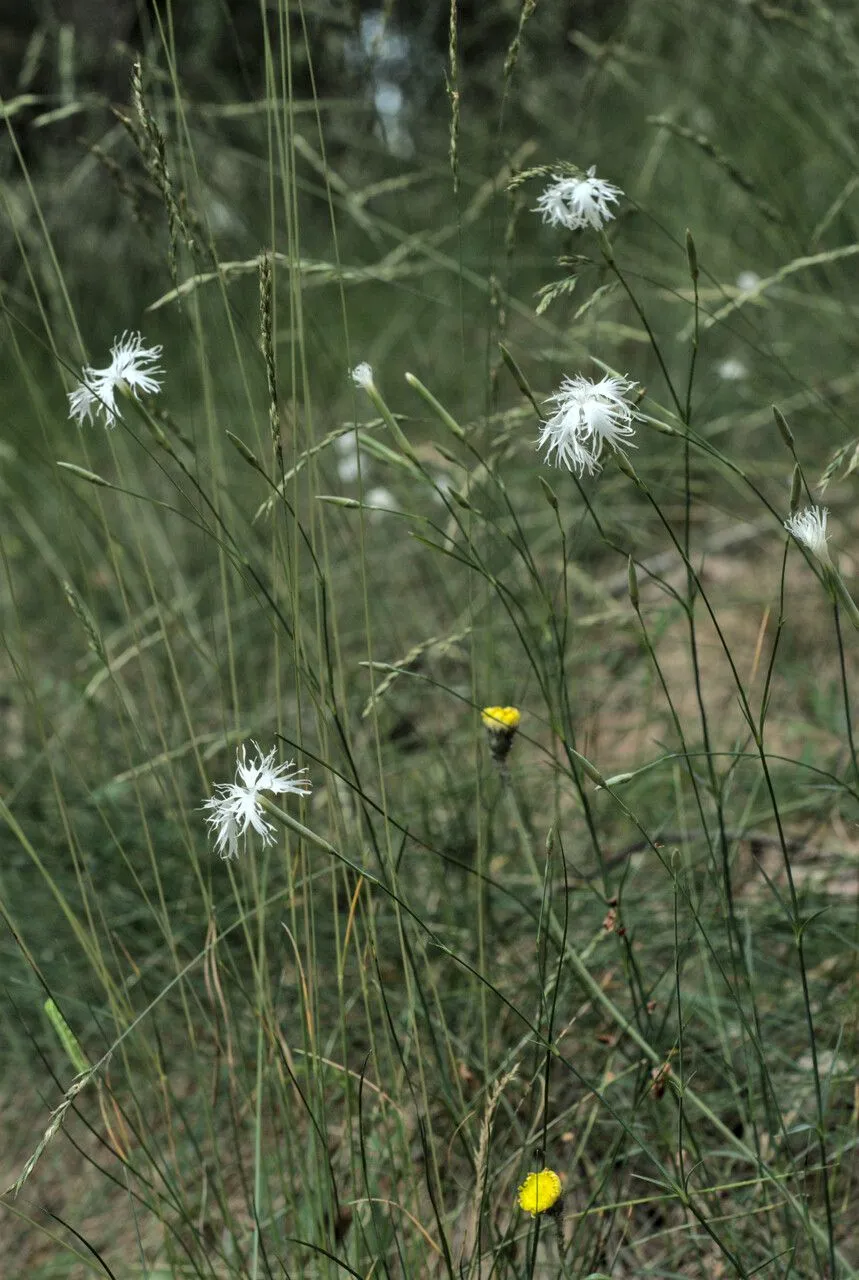
Author: L.
Bibliography: Sp. Pl.: 412 (1753)
Year: 1753
Status: accepted
Rank: species
Genus: Dianthus
Vegetable: False
Observations: S. Sweden, Baltic States
The Finland pink, scientifically known as Dianthus arenarius, is a stunning plant species belonging to the Caryophyllaceae family. First recorded in the “Species Plantarum” in 1753 by the renowned botanist Carl Linnaeus, this delicate flower has captivated plant enthusiasts and botanists alike for centuries.
Native to the sandy regions of southern Sweden and the Baltic States, the Finland pink thrives in nutrient-poor, well-drained soils, often found in coastal landscapes. Its natural habitat highlights the plant’s resilience and adaptability, making it an interesting subject for ecological studies.
Dianthus arenarius features slender, grass-like leaves that form a dense, cushion-like base from which its charming blooms emerge. The flowers themselves are a remarkable sight: the petals are fringed, giving them a ruffled appearance, and they exude a delicate fragrance. Typically, the blooms are a soft pink hue, though variations can occur, adding to the plant’s allure.
Despite its exquisite beauty, the Finland pink is not just a pretty addition to the landscape. It plays a crucial role in its ecosystem, providing nectar for various pollinators, including bees and butterflies. Its ability to thrive in harsh conditions makes it a valuable species for conservation efforts, particularly in regions where soil erosion and habitat degradation pose significant challenges.
For garden enthusiasts, the Finland pink offers not only aesthetic value but also a sense of history and connection to the natural landscapes of northern Europe. Cultivating Dianthus arenarius can be a rewarding endeavor, especially when one considers its historical context and the ecological benefits it brings.
In summary, the Finland pink is much more than just a beautiful plant. It is a testament to nature’s resilience and beauty, firmly rooted in the annals of botanical history and flourishing in some of Europe’s most challenging terrains.
Eng: finland pink, sand pink, stone pink, finnish pink
Fin: hietaneilikka
Swe: hietaneilikka, sandnejlika
Nor: sandnellik
Nld: zandanjer
Fra: oeillet des dunes, oeillet de france
Nno: sandnellik
Nob: sandnellik
En: Finland pink, Stone pink, Sand pink, Finnish pink
Be: Гваздзік пясчаны
Bg: Пясъчен карамфил
Cs: Hvozdík písečný
Da: Sand-Nellike
Nl: Zandanjer
Et: Nõmmnelk
Fi: Hietaneilikka
Fr: Oeillet des dunes, Oeillet de France
De: Sand-Nelke
Lt: Smiltyninis gvazdikas
No: Sandnellik
Nb: Sandnellik
Nn: Sandnellik
Pl: Goździk piaskowy
Ru: Гвоздика песчаная
Sv: Sandnejlika, Hietaneilikka
Taken Jul 17, 2021 by Юрий Басов (cc-by-sa)
Taken Jul 17, 2021 by Юрий Басов (cc-by-sa)
Taken Jul 17, 2021 by Юрий Басов (cc-by-sa)
Taken Jul 9, 2022 by Kristaps Jansons (cc-by-sa)
Taken Aug 22, 2022 by Reinhold Eberhardt (cc-by-sa)
Taken Jun 25, 2010 by Andrzej Pasierbinski (cc-by-sa)
Taken Jul 17, 2021 by Юрий Басов (cc-by-sa)
Taken Jul 17, 2021 by Юрий Басов (cc-by-sa)
Taken Jul 17, 2021 by Юрий Басов (cc-by-sa)
Taken Jul 17, 2021 by Юрий Басов (cc-by-sa)
© copyright of the Board of Trustees of the Royal Botanic Gardens, Kew.
Growth habit>: Forb/herb
Bloom months: [‘jun’, ‘jul’, ‘aug’, ‘sep’]
Family: Myrtaceae Author: (F.Muell.) K.D.Hill & L.A.S.Johnson Bibliography: Telopea 6: 402 (1995) Year: 1995 Status:…
Family: Rubiaceae Author: Pierre ex A.Froehner Bibliography: Notizbl. Bot. Gart. Berlin-Dahlem 1: 237 (1897) Year:…
Family: Sapindaceae Author: Koidz. Bibliography: J. Coll. Sci. Imp. Univ. Tokyo 32(1): 38 (1911) Year:…
Family: Asteraceae Author: A.Gray Bibliography: Pacif. Railr. Rep.: 107 (1857) Year: 1857 Status: accepted Rank:…
Family: Fabaceae Author: Medik. Bibliography: Vorles. Churpfälz. Phys.-Ökon. Ges. 2: 398 (1787) Year: 1787 Status:…
Family: Aspleniaceae Author: (Cav.) Alston Bibliography: Bull. Misc. Inform. Kew 1932: 309 (1932) Year: 1932…